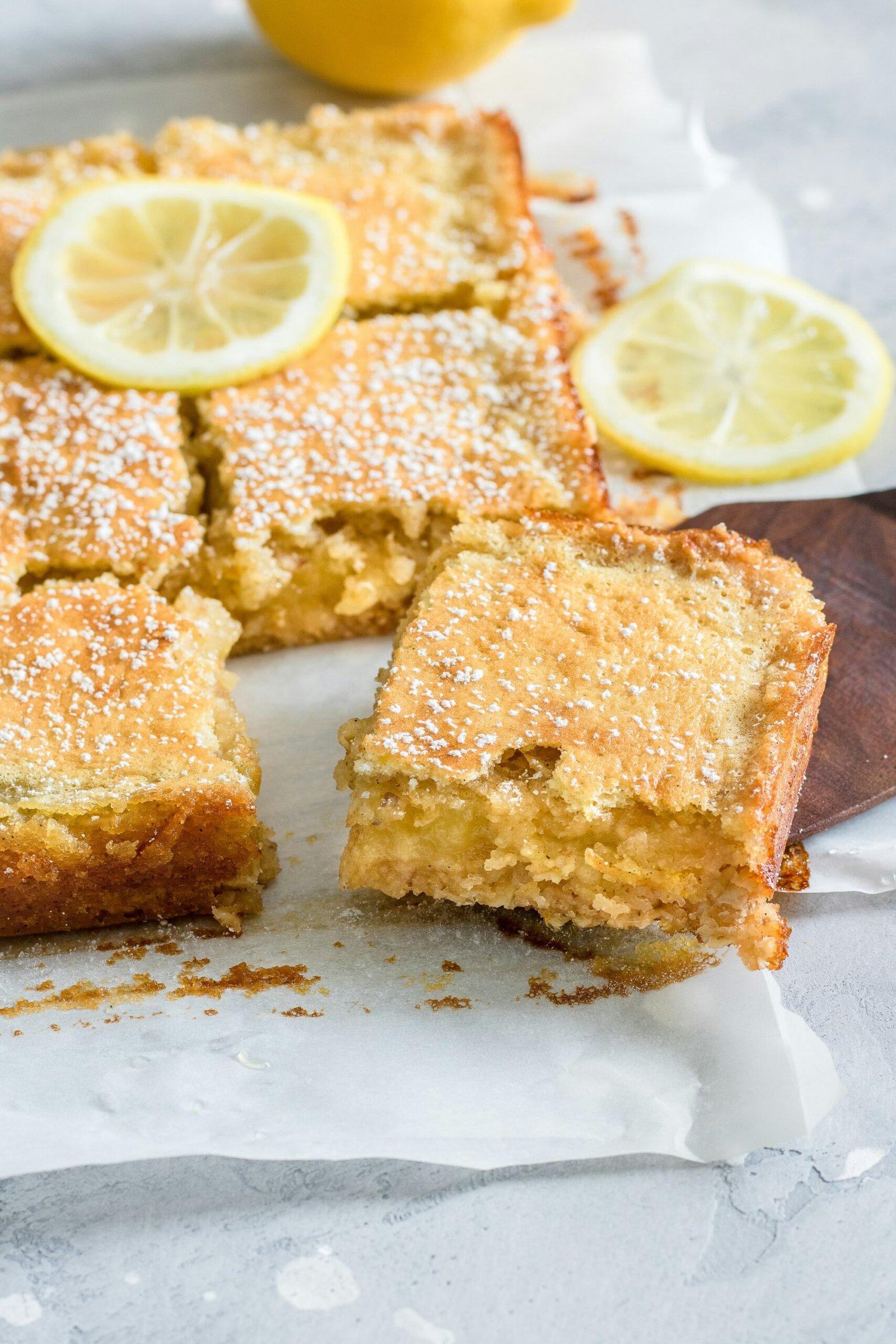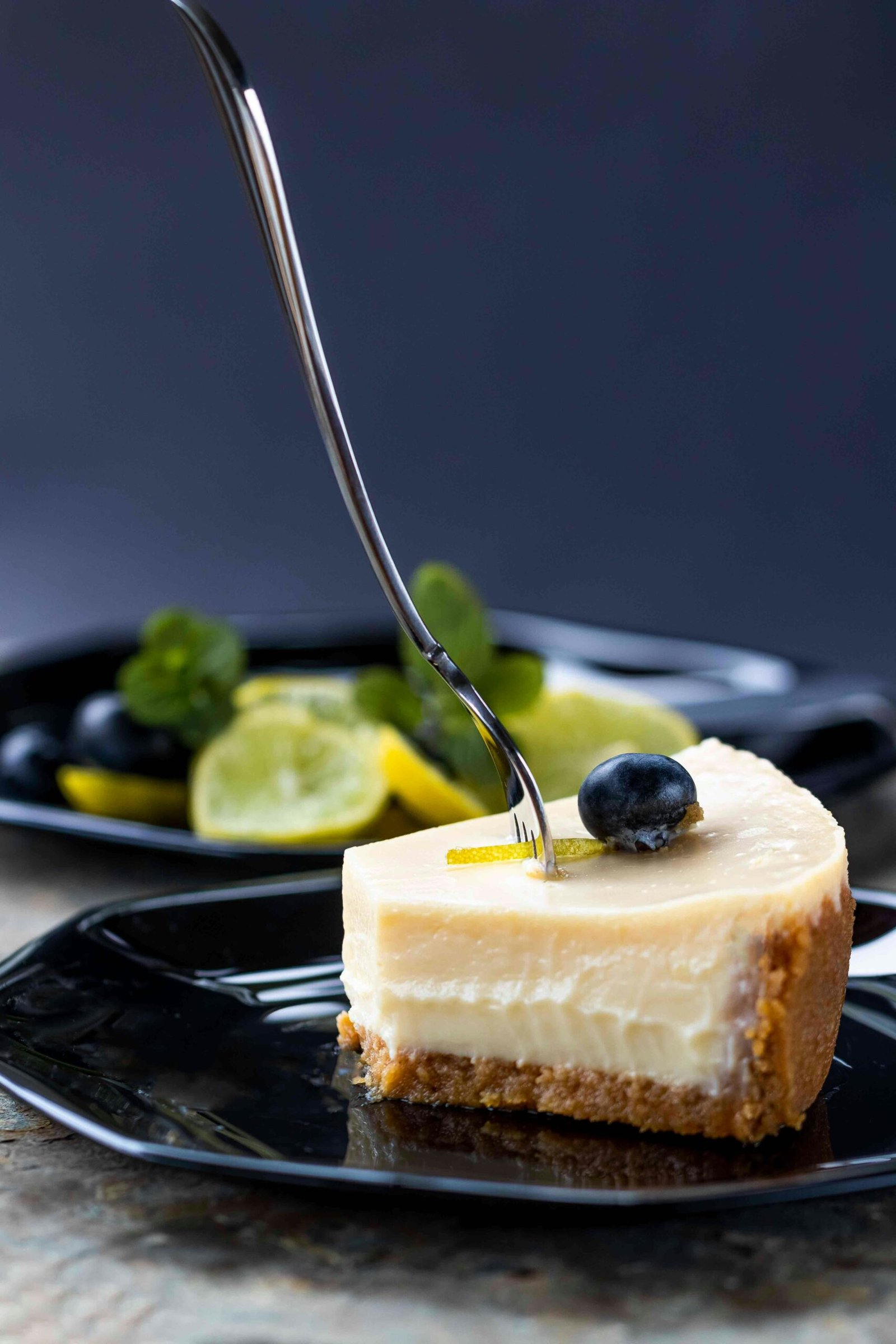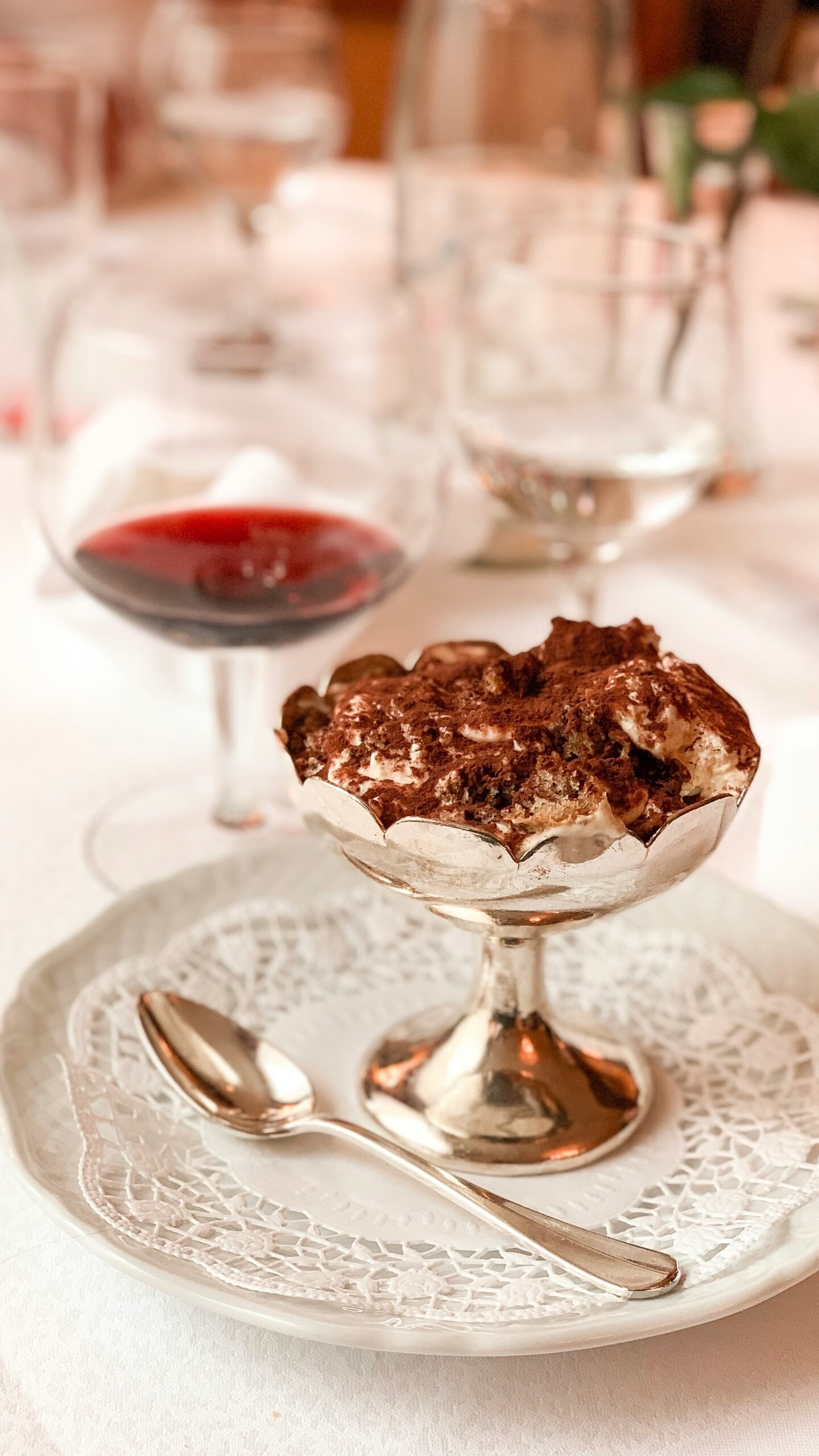Introduction to Lemon Bars
Lemon bars, with their delightful balance of tangy and sweet flavors, have earned a cherished spot in the hearts of dessert lovers for generations. These delectable treats are often associated with warm summer afternoons and joyful family gatherings, making them a nostalgic favorite among many. The origins of lemon bars can be traced back to the early 20th century, when they began to solidify their place in American cuisine. It is believed that they gained popularity during this time due to their simplicity and the accessibility of ingredients needed to prepare them.
The basic structure of a lemon bar consists of a buttery shortbread crust topped with a luscious lemon filling, which is baked to perfection. This combination not only offers a refreshing citrus flavor but also provides a satisfying contrast between the crisp crust and the creamy filling. Over the years, countless variations have emerged, with some incorporating additional ingredients such as meringue or flavored extracts, further enhancing the overall taste experience.
In Melody’s family, lemon bars have become a tradition, often prepared for summer picnics and holiday celebratory events. It is during these gatherings that the warm, inviting aroma of baking lemon bars wafts through the air, drawing everyone into the kitchen. These moments foster a sense of unity as family members come together to enjoy a slice of nostalgia, reminiscing about fond memories while savoring the distinct taste of lemon bars. The addictive nature of these treats ensures that they remain a staple, not just in Melody’s home but in households across the country. Their legacy continues to thrive, reinforced by the joy they bring to both special occasions and everyday life.
What Makes Lemon Bars So Irresistible?
Lemon bars have gained immense popularity as a dessert due to their unique combination of flavors and textures, which create an experience that delights the palate. The bright, tangy flavor of lemon serves as the backbone of this treat, invoking a refreshing citrus profile that enlivens the senses. This tanginess is masterfully balanced by the sweetness of sugar, resulting in a harmonious blend that appeals to a wide range of taste preferences.
In terms of texture, lemon bars present a compelling dichotomy that enhances their allure. The smooth, creamy lemon filling contrasts beautifully with the buttery, crumbly crust. This juxtaposition of rich and zesty elements ensures that each bite is a perfect medley of textures, from the soft filling that melts in your mouth to the firm base that supports it. This combination is not merely pleasing to the taste buds; it also stimulates the senses, making lemon bars an exceptional choice for a satisfying dessert.
The versatility of lemon bars is another reason for their widespread appeal. They can be enjoyed as a light snack, a refreshing dessert after a meal, or even during special occasions like picnics and celebrations. The ease of preparation further contributes to their charm, as they can be made quickly with readily available ingredients. This accessibility makes lemon bars a beloved treat among people of all ages, from children curious about their flavor to adults reminiscing about classic recipes. The enduring popularity of lemon bars stems from their irresistible blend of tangy and sweet notes, combined with contrasting textures that create a delightful dessert experience.
Ingredients for the Perfect Lemon Bars
To create the coveted lemon bars that perfectly balance tangy and sweet flavors, a specific list of ingredients is essential. This recipe highlights everyday kitchen staples alongside a few specialty items that elevate the dish.
For the crust, you will require 1 cup of all-purpose flour, which acts as the base. Additionally, 1/4 cup of powdered sugar is necessary, providing a touch of sweetness that contrasts the tart filling. To ensure a flaky texture, incorporate 1/2 cup of unsalted butter, softened at room temperature. This integral ingredient binds the crust while imparting rich flavor, making it suitable for any lemon bar recipe.
Moving to the filling, you will need 2 large eggs. These provide structure and stability to your lemon bars. In terms of sweetness, measure out 1 cup of granulated sugar, which aids in balancing the tartness of the lemons. The key ingredient is the zest from 2 medium-sized lemons, which infuses a robust citrus aroma and flavor into the bars. Equally critical is 1/2 cup of freshly squeezed lemon juice, yielding that essential tang that defines lemon bars.
For an added burst of flavor, consider including 1/2 teaspoon of baking powder, which works to give the filling a light and airy texture. Lastly, a sprinkle of salt, about 1/4 teaspoon, enhances both the crust and the filling by highlighting the sweetness and acidity of the lemons.
With this comprehensive list of ingredients, you can ensure your lemon bars achieve the ideal balance of tangy and sweet. Prepare these items in advance to facilitate a seamless baking experience, allowing the delightful aroma of freshly baked lemon bars to fill your kitchen.
Step-by-Step Instructions to Create Lemon Bars
To begin preparing your delectable lemon bars, start by preheating your oven to 350°F (175°C). This ensures that the baking process will efficiently bring out the flavors in your treat. Next, we will prepare the shortbread crust. In a medium-sized mixing bowl, combine 1 cup of unsalted butter (softened), ½ cup of granulated sugar, and 2 cups of all-purpose flour. Use a hand mixer or a wooden spoon to blend these ingredients until they form a crumbly yet cohesive mixture. Once completed, press the mixture evenly into the bottom of a greased 9×13 inch baking pan.
Now, place the crust in the preheated oven and bake it for approximately 20 minutes, or until it becomes lightly golden brown. While the crust bakes, let’s move on to the lemon filling. In another bowl, whisk together 1 cup of granulated sugar and 4 large eggs until the mixture is smooth and slightly frothy. Gradually add in 1/2 cup of freshly squeezed lemon juice and the zest from one lemon, continuing to stir until everything is well combined. To ensure a smooth consistency, incorporate 1/4 cup of all-purpose flour, whisking until there are no lumps.
Once the crust has baked and obtained its golden color, remove it from the oven, and carefully pour the lemon filling over the hot crust. Return the pan to the oven and bake for an additional 20-25 minutes. The filling should be set but still slightly jiggly in the center when it is finished. After baking, allow the lemon bars to cool completely in the pan before cutting them into squares or rectangles. For a final touch, dust the top with powdered sugar before serving to enhance both the flavor and appearance of your lemon bars.

Lemon Bars
Ingredients
For the crust:
- 1 1/4 cups all-purpose flour
- 1/2 cup powdered sugar
- 1/4 teaspoon salt
- 1/2 cup cold unsalted butter cut into cubes
For the lemon filling:
- 3 large eggs
- 1 cup granulated sugar
- 1/4 cup all-purpose flour
- 1/4 cup lemon juice
- 1 tablespoon lemon zest
- 1/4 teaspoon salt
Instructions
Make the crust:
- In a large bowl, combine the flour, powdered sugar, and salt.
- Cut in the cold butter using a pastry blender or your fingertips until the mixture resembles coarse crumbs.
- Press the crumbs into the bottom of a 9x13 inch baking pan.
- Bake in a preheated 350°F oven for 15-20 minutes, or until golden brown. Let cool completely.
Make the lemon filling:
- In a large bowl, whisk together the eggs, sugar, flour, lemon juice, lemon zest, and salt until smooth.
- Pour the lemon filling over the cooled crust.
Bake the bars:
- Bake in a preheated 350°F oven for 25-30 minutes, or until the filling is set.
- Let cool completely before cutting into squares.
- Enjoy!
Notes
Prep time: 30 minutes
Bake time: 25-30 minutes
Tips for Perfecting Your Lemon Bars
To achieve the perfect lemon bars, attention to detail is paramount. Start with the crust, as it serves as the foundation of your dessert. Ensure that the crust is baked until it turns a light golden brown. This not only adds flavor but also provides a strong structure that supports the tangy lemon filling. Undercooked crust may lead to a soggy base that detracts from the overall experience of your lemon squares.
Next, opt for fresh lemon juice over bottled alternatives. Freshly squeezed lemon juice enhances the flavor profile of your lemon bars and provides that vibrant tartness synonymous with this treat. Additionally, using fresh zest will amplify the aromatic qualities, adding a delightful fragrance that complements the dish. Remember that the quality of your ingredients directly impacts the final product, so choose ripe lemons for the best results.
Cooling is another critical step often overlooked. After baking, allow your lemon bars to cool at room temperature for at least an hour before refrigerating them. This cooling period enables the filling to set properly, which is essential for clean slices. Nonetheless, do not rush this process—cutting into warm bars will result in messy squares, which may undermine the aesthetic appeal.
Common pitfalls can often be resolved with simple adjustments. For instance, if you find your lemon bars are too sweet, reducing the sugar in the filling can help balance the flavors. Conversely, if they are too tart, a touch more sugar might make them more palatable. Finally, keep an eye on the baking time, as ovens can vary. Use a toothpick to test the center for doneness; it should come out clean when the bars are ready. By implementing these tips, you can craft lemon bars that are not only visually appealing but also irresistibly delicious.
Creative Variations on the Classic Lemon Bar Recipe
The classic lemon bar is a delectable dessert known for its balance of tangy and sweet flavors, making it a favorite among many. However, creativity in the kitchen can elevate this timeless treat even further. By making slight adjustments or adding unique ingredients, bakers can create exciting variations on the traditional lemon bar recipe that cater to diverse taste preferences.
One delightful twist is incorporating fresh berries into the filling. Raspberries, blueberries, or blackberries can complement the tartness of the lemon, providing an additional layer of flavor and texture. Simply fold in the berries gently into the lemon mixture before baking, ensuring that each bite bursts with fruitiness.
For those looking to introduce a tropical flair, consider replacing the lemon juice with lime juice. Lime bars offer a similar zestiness and are equally refreshing, making them perfect for summer gatherings. This variation not only changes the flavor profile but also embraces the vibrant green color of limes, resulting in visually appealing treats.
Another creative approach is to incorporate shredded coconut into the crust or the filling. This addition introduces a chewy texture and a subtle hint of nuttiness, enhancing the overall flavor experience. Toasting the coconut beforehand can bring out its natural sweetness and add a richer aroma that will surely captivate anyone who takes a bite.
Ultimately, the key to a successful lemon bar variation lies in experimenting with different ingredients while maintaining the core essence of the dish. Using alternatives such as almond extract instead of vanilla or adding a sprinkle of sea salt on top can create unexpected taste sensations, inviting both novice and experienced bakers alike to explore their culinary boundaries.
Serving Suggestions for Lemon Bars
Lemon bars, with their quintessential tangy-sweet flavor, can be elevated through thoughtful presentation and pairing suggestions. To start, consider the serving platter. A white ceramic or glass dish creates a beautiful contrast against the vibrant yellow of the lemon bars, enhancing visual appeal. For an added touch, you may arrange the bars in a neat grid, ensuring that each piece is uniform in size for an attractive display.
To garnish the lemon bars effectively, a light dusting of powdered sugar is a classic choice. This not only adds an appealing finish but also introduces a touch of sweetness that complements the tartness of the lemon. For a more vibrant option, consider fresh fruit garnishes, such as raspberries or strawberries. Placing a few berries alongside the lemon bars provides a pop of color and creates an inviting presentation that guests will find irresistible.
When it comes to pairing, serving lemon bars with a dollop of whipped cream can enhance the overall experience. The creamy texture contrasts beautifully with the zesty filling, adding a layer of indulgence. Alternatively, for a refreshing twist, a scoop of vanilla ice cream serves as a delightful accompaniment, providing a cool contrast to the warm citrus flavors.
Beverage choices also play a crucial role in complementing lemon bars. Pairing them with a cup of freshly brewed tea, such as Earl Grey or green tea, can be a sophisticated option. The subtle flavors of the tea can balance the richness of the dessert, creating a harmonious pairing. For a more festive approach, consider serving lemon bars with a sparkling drink or lemonade, amplifying the citrus theme.
Through these serving suggestions, you can transform your lemon bars from a simple treat into a sophisticated dessert experience that will be sure to impress your guests.
Nutritional Information for Lemon Bars
Lemon bars, known for their tangy-sweet flavor, also bring a noteworthy nutritional profile to the table. A standard serving of lemon bars, typically one piece measuring about 2 inches by 2 inches, contains approximately 200 calories. These delightful treats predominantly derive their calories from carbohydrates, which can range from 25 to 30 grams per serving. The recipe usually includes sugar, flour, and butter, contributing to this carbohydrate-rich profile.
When examining the macro-nutrient distribution, each serving offers roughly 2 to 3 grams of protein and 8 to 10 grams of fat. The fats present in lemon bars are primarily attributed to the butter used in the crust and custard filling. While these fat grams are a substantial part of the overall caloric content, it is essential to consider the type of fats used. Opting for unsalted butter or substituting with healthier fat sources, such as coconut oil, may modify the overall nutritional impact. Additionally, for those following a specific dietary regime, utilizing alternative sweeteners like stevia or erythritol can significantly reduce both calorie count and sugar intake while maintaining the sweetness of the dessert.
Lemon bars also provide beneficial nutrients, particularly vitamin C, due to the fresh lemon juice used in the filling. One serving can contain up to 20% of the recommended daily intake of vitamin C, which is essential for immune function and skin health. Incorporating zest from the lemon not only enriches the flavor but adds additional antioxidant benefits. Thus, with thoughtful ingredient choices, lemon bars can be enjoyed in a more health-conscious manner without sacrificing their signature taste.
The Perfect Occasions for Making Lemon Bars
Lemon bars, with their zesty and sweet flavor profile, are an irresistible treat that suits a variety of occasions. Their bright, tangy taste makes them particularly popular during the warmer months, making them a perfect addition to summer picnics and barbecue gatherings. The refreshing nature of lemon bars provides a delightful contrast to traditional heavy desserts, allowing guests to indulge without feeling overwhelmed. For a relaxed outdoor lunch, serving these bars atop a picnic blanket will undoubtedly elevate the entire experience.
Moreover, lemon bars are a fantastic choice for holiday events. Their vibrant yellow color can brighten up any festive spread, making them a delightful alternative to the usual holiday desserts. From Easter celebrations to rooftop parties during the Fourth of July, the citrusy flavor embodies the essence of summer while simultaneously fitting in with seasonal themes. Their versatile nature ensures that they can complement a range of dishes, from savory to sweet, making them an excellent pick for any potluck or gathering.
In addition to casual festivities, lemon bars also lend themselves well to more formal occasions. They can be easily cut into neat squares, making them suitable for cocktail parties or elegant brunches. Imagine serving these delectable treats alongside sparkling beverages or freshly brewed coffee; the combination can create a sophisticated atmosphere that guests will appreciate. Furthermore, their simplicity in preparation means that even novice bakers can feel confident in serving them at such events, helping to instill a sense of achievement when entertaining loved ones.
Overall, the occasions for making lemon bars are plentiful. Whether you’re celebrating casual moments or hosting formal gatherings, these delectable treats offer a perfect, delicious solution that is sure to delight everyone involved.
Common Questions About Lemon Bars
Lemon bars are a delightful treat enjoyed by many, and it is natural to have questions about their preparation and storage. One commonly asked question is how to store lemon bars once they have been made. To maintain their freshness, it is advisable to keep lemon bars in an airtight container at room temperature for up to two days. If you would like to prolong their shelf life, refrigerating them will allow them to last for about a week. Ensure that the container is sealed tightly to prevent any moisture or strong odors from affecting the tangy flavor of the lemon bars.
Another frequent inquiry is regarding the duration for which lemon bars can last. When stored properly, lemon bars can maintain their quality for approximately one week in the refrigerator. It is important to keep an eye on their appearance and smell; if they begin to look off or develop a strange odor, it may be best to discard them. Therefore, it is recommended to bake lemon bars in small batches if you are unsure you can consume them all within a week.
One of the appealing attributes of lemon bars is their versatility in storage options. Many people wonder, “Can lemon bars be frozen?” The answer is a resounding yes. Freezing lemon bars can help preserve their flavor and texture. To freeze them, allow the bars to cool completely and then cut them into squares. Wrap each square tightly in plastic wrap, followed by aluminum foil to prevent freezer burn. When stored this way, lemon bars can last for up to three months in the freezer. When ready to enjoy, simply thaw them in the refrigerator overnight. This makes them a convenient dessert to prepare in advance for gatherings or special occasions.
Personal Anecdotes and Memories of Lemon Bars
The aroma of freshly baked lemon bars fills the kitchen with a sense of nostalgia that transports me back to my childhood. My earliest memories of these delightful treats are intertwined with family gatherings during warm summer afternoons. Each year, as the sun bathed our backyard in golden light, my grandmother would whip up her famous lemon bars, a recipe passed down through generations. The combination of tangy lemon zest and buttery shortbread created an irresistible dessert that brought the entire family together.
Every bite of those luscious lemon bars was a culinary experience, yet they also marked important milestones in my life. I vividly remember my first attempt at recreating my grandmother’s recipe as a teenager. With a mixture of excitement and anxiety, I gathered the ingredients, carefully measuring lemon juice and sugar. However, instead of the zesty treats I had anticipated, I ended up with a gooey mess. It was a lesson in patience and perseverance – sometimes, you must embrace failures before achieving success. This experience ignited my passion for baking, and I’ve continued to experiment with various combinations and techniques over the years, each time honing my skills.
As I eventually mastered the art of baking lemon bars, these treats became synonymous with celebrations in my home. Birthdays, holidays, and casual get-togethers often featured this beloved dessert, a testament to their timeless appeal. There is something uniquely satisfying about watching friends and family savor each bite, their faces lighting up in delight. Lemon bars have transformed from a treasured childhood memory into a cherished family tradition, reminding me that cooking can create bonds that last for generations.
Lemon Bars in Popular Culture
Lemon bars, with their delightful combination of tangy lemon flavor and sweet, buttery crust, have made notable appearances in popular culture, celebrating their enduring appeal. These delicious desserts have transcended the confines of home kitchens to become symbols of nostalgia and comfort, often featured in various media forms.
In film and television, lemon bars have been portrayed as quintessential homemade treats that evoke a sense of family and warmth. For instance, in classic movies and contemporary series alike, characters are frequently seen enjoying or sharing lemon bars at gatherings, thereby reinforcing their status as a beloved dessert. This portrayal reinforces the idea that lemon bars are not merely a recipe but a tangible connection to cherished moments and memories.
Cookbooks and food blogs have also played a significant role in popularizing lemon bars. Many renowned chefs and culinary enthusiasts have included their unique takes on this dish, further embedding it into the culinary consciousness. Variations such as gluten-free lemon bars or vegan versions serve to broaden the lemon bar appeal, catering to diverse dietary preferences while maintaining the essence of the traditional recipe.
Moreover, lemon bars have even made their way into celebratory events and social media platforms, where viral food trends often feature vibrant images of these treats. From Instagram feeds filled with stunning lemon bar presentations to TikTok challenges showcasing creative takes on the dessert, lemon bars remain a favorite among food lovers. As such, their presence in popular culture highlights their versatility and the joy they bring to both baking enthusiasts and dessert lovers.
Tips for Hosting a Lemon Bar Tasting
Hosting a lemon bar tasting is an enjoyable way to explore the myriad of flavors and variations that can be achieved with this classic dessert. Start by creating a lemon-themed atmosphere that reflects the vibrant and refreshing essence of lemon bars. Decorate the space with yellow tablecloths, lemon centerpieces, and bright citrus-colored serving platters. To further enhance the theme, consider using lemon-scented candles or essential oils that create an inviting scent in the air.
When it comes to inviting guests, encourage friends and family to bring their own versions of lemon bars. This not only creates a diverse tasting experience but also fosters a sense of community and creativity among participants. Each guest can experiment with their unique recipe, whether that’s a classic lemon bar, vegan variations, or lemon bars infused with additional flavors such as lavender or coconut. Providing a variety of tasting options enables everyone to appreciate the differences in texture and taste.
To make the tasting even more interactive, prepare feedback cards for each lemon bar variation. Invite your guests to note their thoughts on elements such as sweetness, tartness, and texture for each recipe sampled. At the end of the tasting, you can gather everyone to share their favorite creations, allowing for an engaging discussion on the qualities that were most enjoyable. This not only highlights the creativity involved in baking but also encourages participants to refine their recipes based on communal feedback.
Hosting a lemon bar tasting party is an excellent way to celebrate food, creativity, and friendship. These events not only give individuals an opportunity to share their culinary skills but also allow for an enriched experience centered around the delightful flavor of lemon bars, making it a memorable occasion for everyone involved.
How to Make Lemon Bars With Kids
Involving children in the kitchen can be a delightful experience, especially when making delicious treats like lemon bars. This process not only teaches children valuable cooking skills but also allows for quality bonding time. To make lemon bars together, begin by gathering all the necessary ingredients and equipment. Ensure everything is within reach to keep children engaged.
To introduce kids to the world of baking, assign them straightforward tasks. Younger children can assist with washing the lemons and measuring out ingredients like sugar and flour. These simple responsibilities allow them to feel like they are contributing to the recipe without overwhelming them. While handling kitchen equipment, it is crucial to demonstrate safe practices, such as how to properly use a measuring cup or whisks.
As you work through the lemon bar recipe, encourage creativity by suggesting variations to the traditional lemon flavor. For example, offer options like adding fresh herbs, such as mint, or incorporating different citrus fruits. Kids often enjoy personalizing their treats, and this can make the baking experience even more enjoyable. If possible, let them decorate the final product with powdered sugar or citrus zests, turning the lemon bars into a canvas for their culinary creations.
Another fun activity involves letting children take charge of the cleanup process once the baking is done. Teach them how to organize and wash the utensils and mixing bowls. Not only does this instill a sense of responsibility, but it also emphasizes the importance of maintaining a tidy cooking space. From start to finish, making lemon bars can be an enriching experience that nurtures the joys of cooking and family interaction.
Tips for Perfecting the Shortbread Crust
Creating the perfect shortbread crust is essential for delicious lemon bars, as it provides a complementary texture and flavor that enhances the tangy filling. To achieve an ideal shortbread crust, attention to detail in the preparation process is crucial. Start by selecting high-quality ingredients; the choice of butter, flour, and sugar significantly impacts the final result. Using unsalted butter allows for better control over the saltiness, while all-purpose flour is typically the best option for a light yet sturdy crust.
One of the fundamental aspects of making a perfect shortbread crust is the method of combining the ingredients. Begin by creaming the butter and sugar together until the mixture is light and fluffy. This step incorporates air into the mixture, which contributes to a tender texture. It is important not to overmix the dough once the flour is added; a few gentle folds should suffice. Overworking the flour leads to a tough texture, which is undesirable for lemon bars.
Chilling the dough is another critical step that should not be overlooked. Once your shortbread mixture is prepared, wrap it in plastic wrap and refrigerate it for at least 30 minutes. Chilling helps the fat solidify, preventing the dough from spreading too much during baking and helps to create a firmer, flakier crust. When it’s time to bake, ensure that the oven is preheated to the correct temperature, as this guarantees even cooking.
Finally, blind-baking the crust will enhance its texture and prevent sogginess. Line the crust with parchment paper and fill it with pie weights or dried beans to keep it flat while baking. This technique ensures that the shortbread crust remains crisp and holds up well against the sweet and tangy lemon filling. Following these tips will set you on the path to perfecting a shortbread crust that is flavorful and texturally satisfying for your lemon bars.
The Science Behind the Lemon Filling
The lemon filling in lemon bars is a remarkable combination of ingredients that not only contributes to the distinctive flavor but also affects the texture and consistency of the dessert. Key ingredients such as fresh lemon juice, sugar, and eggs play crucial roles in creating that creamy, tangy layer characteristic of an excellent lemon bar. Understanding these components and their interactions sheds light on the science behind this delightful treat.
Fresh lemon juice serves as the foundation of the filling’s tartness. It contains citric acid, which imparts a bright, vibrant flavor that balances the sweetness from the sugar. The acidity also aids in the overall thickening of the filling while interacting with the sugar to create a harmonious blend of tastes. When combined with sugar, lemon juice helps to achieve a syrupy consistency, which helps set the filling as it bakes.
Sugar is not only a sweetener but also a crucial ingredient that affects the baking process. It serves to enhance the flavor while also contributing to texture. During baking, the sugar dissolves and, together with the eggs, forms a smooth custard-like filling. This interaction results in a creamy consistency that is essential for a successful lemon bar. Furthermore, when sugar is heated, it caramelizes to a degree, further enhancing the flavor complexity of the filling.
Eggs are vital in binding the filling together. They act as a stabilizing agent, allowing the mixture to achieve the desired firmness as it cools. The proteins in the eggs coagulate during baking, solidifying the filling and providing structure. This balance between the acidity of lemon juice, the sweetness from sugar, and the proteins from eggs culminates in the addictive lemon filling that makes the bars so irresistible. An understanding of this interaction can empower bakers to experiment and perfect their own lemon bars.
Lemon Bars for Different Diets
Lemon bars are a beloved treat, but dietary restrictions may prevent some individuals from enjoying them. Fortunately, adapting the traditional lemon bars recipe to accommodate various dietary preferences is not only feasible but can also yield delicious results. Below, we explore how to make gluten-free, vegan, and low-sugar lemon bars, ensuring everyone can savor this tangy and sweet delight.
For those following a gluten-free diet, the flour can be substituted with gluten-free alternatives such as almond flour, coconut flour, or a gluten-free all-purpose flour blend. Each option brings different textures and flavors to the dish. Almond flour tends to result in a moist and slightly nutty flavor, while coconut flour can create a denser texture. It is essential to adjust the liquid content when using coconut flour to maintain the desired consistency.
To cater to vegan diets, replacing eggs in the lemon bar recipe is necessary. Flaxseed meal or chia seeds mixed with water can serve as an effective binder. The general rule is to mix one tablespoon of flaxseed meal or chia seeds with two and a half tablespoons of water, allowing it to sit until it becomes gel-like. This substitution may transform the texture slightly, but it remains enjoyable and satisfying. Additionally, using a plant-based butter alternative instead of regular butter maintains that rich flavor essential to the lemon bars.
For those seeking a low-sugar version, natural sweeteners like stevia, erythritol, or monk fruit can replace granulated sugar. While these substitutes can significantly reduce the caloric content, it is crucial to note that they may alter the overall sweetness and texture of the lemon bars. Additionally, adjusting the amount used to align with the equivalent sweetness of sugar ensures the balance between tartness and sweetness is preserved.
By making these substitutions thoughtfully, lemon bars can be delightful treats that accommodate diverse dietary needs without sacrificing taste or texture.
Storing and Reheating Lemon Bars
Proper storage of lemon bars is crucial for preserving their freshness and delightful flavor. After baking, allow the lemon bars to cool completely at room temperature. Once they have cooled, it is essential to cover them adequately to maintain their quality. For short-term storage, place the lemon bars in an airtight container. This can prevent air exposure, which may lead to drying out and loss of flavor. Alternatively, you may wrap them tightly with plastic wrap or aluminum foil if a container is unavailable. When stored correctly at room temperature, lemon bars can remain fresh for up to three days. However, if you want to prolong their shelf life, refrigerating them is advisable.
When storing lemon bars in the refrigerator, ensure they are covered to protect against odors and moisture, which can affect the texture. They can last in the refrigerator for about a week without significant deterioration in taste or quality. For even longer storage, consider freezing your lemon bars. To do this, cut them into individual portions, wrap each piece in plastic wrap, and then place them in a freezer-safe container. This method allows you to enjoy a slice whenever you crave the tangy sweetness without compromising the overall quality. Frozen lemon bars can last for up to three months in the freezer.
When it comes to reheating lemon bars, it is crucial to do it gently to avoid altering their delightful texture. If reheating from the refrigerator, simply allow the bars to come to room temperature before serving. For a warm treat, consider placing them in a preheated oven at a low temperature of around 300°F (150°C) for approximately 10 minutes. For those who enjoy the chilled version, lemon bars can also be served straight from the refrigerator, maintaining their refreshing tanginess. The proper storage and reheating methods ensure that you can savor each bite of this tempting dessert long after you first make them.
Encouragement to Try the Recipe
As we reach the end of this delightful lemon bars journey, I wish to extend a warm invitation to all of you to try your hand at this recipe. Baking lemon bars is not just about following a list of ingredients; it is an experience that combines the joy of creating something delicious and the satisfaction of enjoying your own homemade treat. The enchanting combination of tangy lemon zest and sweet, buttery crust creates an irresistible dessert that is sure to be a hit among friends and family.
For those who have never attempted baking before, this lemon bars recipe is an excellent starting point. The process is straightforward, and the ingredients are likely already available in your kitchen. By taking this small step, you will not only learn valuable techniques but also discover the wonders of baking from scratch. Imagine the sense of accomplishment you will feel when serving these charming lemon bars to your loved ones, perhaps even with a dusting of powdered sugar to perfect the presentation.
I encourage you to personalize this recipe by experimenting with different variations. You could try adding a hint of coconut to the crust or experimenting with different citrus fruits for a unique flavor twist. Each attempt will teach you something new and bring you closer to the perfectly balanced lemon bars you envision. I would love to hear about your experiences, whether they involve triumphs or humorous baking mishaps. Please consider sharing your stories in the comments section below, fostering a community of fellow home bakers eager to learn and grow together.
Your culinary journey awaits, so gather your ingredients, preheat your oven, and let’s create some lemony goodness that will brighten your day and those around you. Happy baking!














